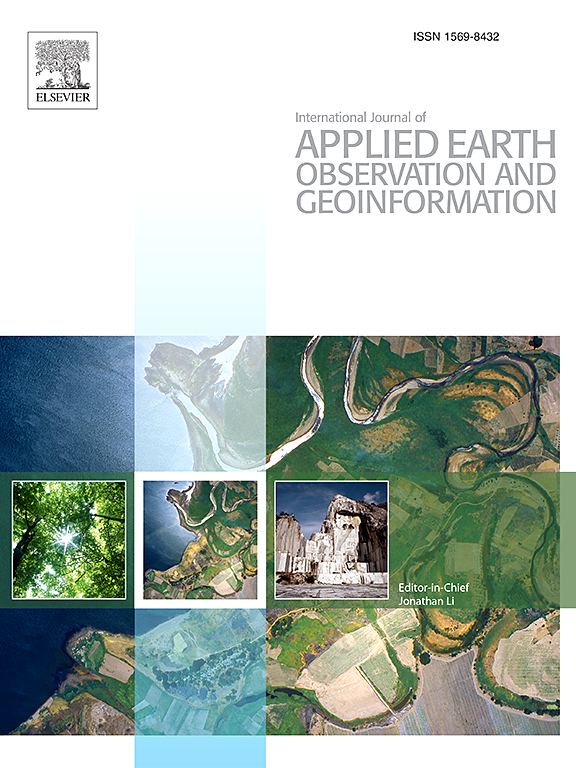遮挡映射揭示了飞行和传感参数对基于无人机的高性价比激光扫描垂直森林结构勘探的影响
IF 7.6
Q1 REMOTE SENSING
International journal of applied earth observation and geoinformation : ITC journal
Pub Date : 2025-04-03
DOI:10.1016/j.jag.2025.104493
引用次数: 0
摘要
最近的研究表明,无人驾驶飞行器(uav)的光探测和测距(LiDAR)在评估森林结构方面具有潜力。最大化数据的完整性和代表性是准确检索关键结构参数的关键。然而,关于数据采集方法如何影响冠层体积勘探的知识很少。本研究使用成本效益高的传感器系统调查了中欧森林中选定的传感和飞行设置对冠层遮挡的影响。我们使用大疆matrix 300 RTK无人机和大疆Zenmuse L1激光雷达传感器,在不同的飞行速度、方位飞行方向、传感器倾斜角度和扫描模式组合下进行了44次飞行。利用传感器位置重建和光线追踪算法对遮挡进行量化,我们发现:(1)传感器倾角增大至15°时,遮挡总量增加,增强了冠层上部的探测能力,同时由于冠层穿透性降低,遮蔽量减小。(2)线性扫描模式下的多个方位飞行,由于提高了不同视角的覆盖范围,垂直遮挡降低了15.0%。(3)与线性模式相比,Lissajous扫描模式导致的垂直遮挡减少了10.1%,强调了额外视角的重要性。基于这些研究结果,我们建议:(a)将最低点采样纳入冠层下评估;(b)利用离谷底角度对上冠层进行评价;(c)最大化采样视角和视角,以减少遮挡效应。我们的研究结果为优化无人机激光雷达数据采集提供了可转移的见解,从而有助于增强结构度量检索和改进森林功能特性的分析。本文章由计算机程序翻译,如有差异,请以英文原文为准。

Occlusion mapping reveals the impact of flight and sensing parameters on vertical forest structure exploration with cost-effective UAV based laser scanning
Recent studies have demonstrated the potential of light detection and ranging (LiDAR) from uncrewed aerial vehicles (UAVs) for assessing forest structures. Maximizing data completeness and representativeness is essential to accurately retrieve key structural parameters. However, knowledge on how data acquisition approaches affect canopy volume exploration is sparse. This study investigated the effects of selected sensing and flight settings on canopy occlusion in a central European forest using a cost-effective sensor system. We conducted 44 flights with a DJI Matrice 300 RTK UAV and a DJI Zenmuse L1 LiDAR sensor, with different combinations of flight speed, azimuthal flight directions, sensor tilt angles, and scan patterns. Using sensor position reconstruction and a ray tracing algorithm to quantify occlusion, we found that: (1) A larger sensor tilt angle up to 15° increased total occlusion, enhancing exploration in the upper canopy, while decreasing it below due to reduced canopy penetration. (2) Flying multiple azimuthal directions with a linear scanning mode reduced vertical occlusion by up to 15.0% due to improved coverage from diverse perspectives. (3) Lissajous scanning patterns resulted in 10.1% less vertical occlusion compared to linear patterns, underscoring the importance of additional viewing angles. Based on these findings, we recommend: (a) incorporating nadir sampling for below-canopy assessment; (b) using off-nadir angles for upper canopy evaluation; and (c) maximizing sampling perspectives and viewing angles to reduce occlusion effects. Our results offer transferable insights to optimize UAV LiDAR data acquisitions, thereby contributing to an enhanced structural metric retrieval and improved analysis of forest functional properties.
求助全文
通过发布文献求助,成功后即可免费获取论文全文。
去求助
来源期刊

International journal of applied earth observation and geoinformation : ITC journal
Global and Planetary Change, Management, Monitoring, Policy and Law, Earth-Surface Processes, Computers in Earth Sciences
CiteScore
12.00
自引率
0.00%
发文量
0
审稿时长
77 days
期刊介绍:
The International Journal of Applied Earth Observation and Geoinformation publishes original papers that utilize earth observation data for natural resource and environmental inventory and management. These data primarily originate from remote sensing platforms, including satellites and aircraft, supplemented by surface and subsurface measurements. Addressing natural resources such as forests, agricultural land, soils, and water, as well as environmental concerns like biodiversity, land degradation, and hazards, the journal explores conceptual and data-driven approaches. It covers geoinformation themes like capturing, databasing, visualization, interpretation, data quality, and spatial uncertainty.
 求助内容:
求助内容: 应助结果提醒方式:
应助结果提醒方式:


